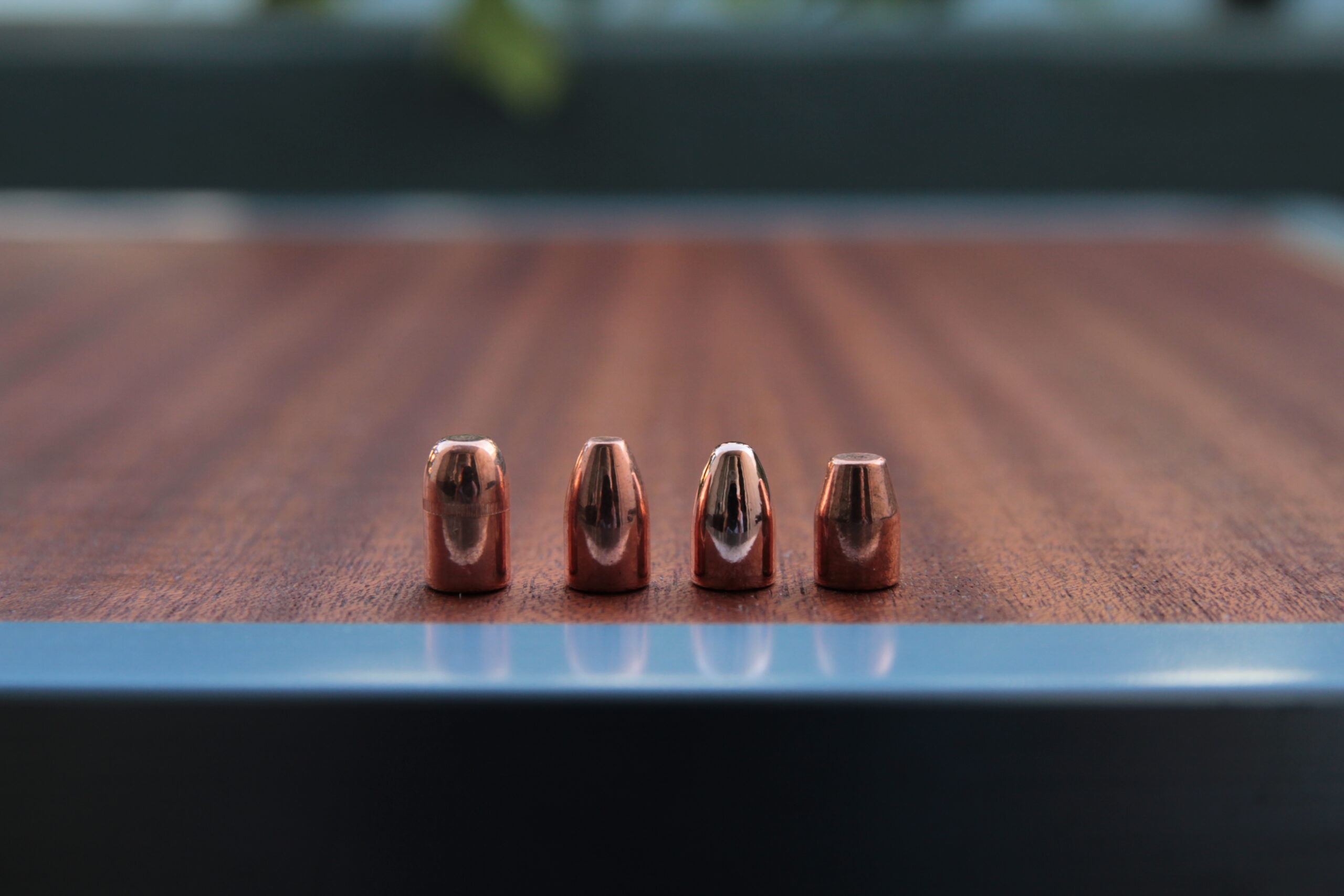There’s an elephant in the room, and his name is Chapter 11. When I started writing this article I would have told you Xtreme Bullets was the gold standard for plated pistol bullets. That may still be the case, but when someone files for bankruptcy it’s rarely good news.
Had you asked me 3 months ago this is what I would have told you: Plated bullets are the shit! If you need an inexpensive solution for high volume pistol shooting look no further than Xtreme bullets, or X-treme Bullets, or extreme bullets. Spell it however you want, Google knows what you’re looking for. Google knows EVERYTHING you’ve looked for.
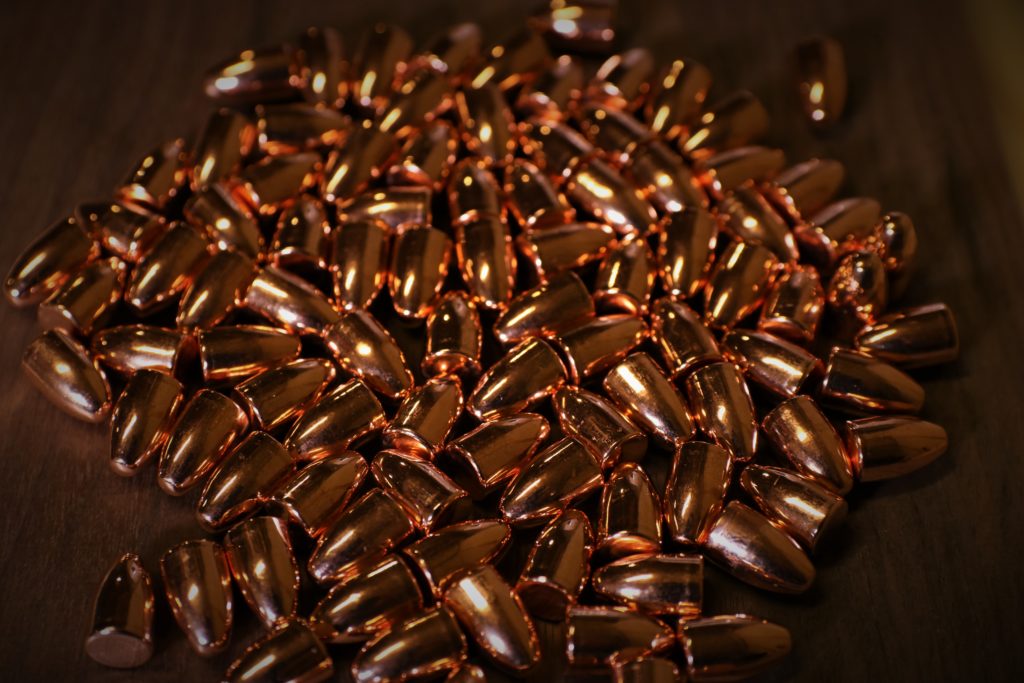
Xtreme Bullets
Back in 1990 there was a company called West Coast Bullet out of Carson, NV that made bullets for reloaders. The company sold and the name was changed to Accura. I believe Accura was located in Nampa, ID. Shortly afterwards the original owners bought the company back and renamed it Xtreme. I believe this was 2004-ish. From that point on Xtreme started to take off ,and made the smart decision to vertically integrate the business.
The parent company that owns Xtreme is called Howell Munitions and Technology (HMT). HMT had another business that manufactured loading equipment named Ammo Load Worldwide. Xtreme made bullets, Ammo Load made commercial reloading equipment, so they connected the dots and started producing their own ammo called Freedom Munitions in 2010. If I’ve got my facts straight Carson, NV just plates bullets, and their second factory in Lewiston, ID houses Freedom Munitions and Ammo Load.
Everything was running relatively smoothly until recently. The parent company filed Chapter 11, and it’s unclear what is going to happen. I’ll update this post once I know more.
Types of Bullets
To understand how plated bullets are different from the other options let’s dig into all bullet types.
Cast Lead Bullets:
This is the simplest bullet type. You take molten lead and pour it into a mold, and then allow the casts to air dry or you can water quench them. After the cast bullets cool down they are lubed and resized. The resizing gives the bullet it’s final diameter. This is important because variation in casting temperature, mold size, and lead alloy composition can affect the diameter of the casting. Resizing ensures you get the exact diameter you’re looking for. Bullet diameter is critical because over-sized bullets cause elevated pressure. Undersized bullets cause extreme leading in the bore and the rounds will often tumble.
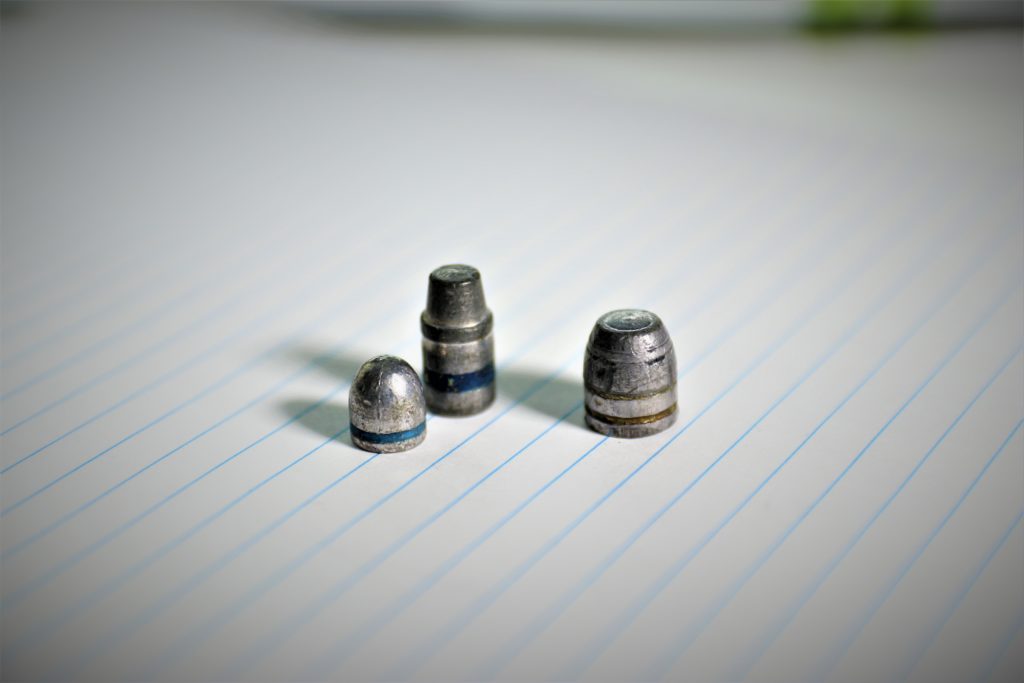
Cast Lead Bullets
Lubing the bullet helps prevent the soft lead from galling as it is pushed down the bore (insert ass joke here). It also helps seal the gas behind the bullet as it goes down the bore. The linear and radial acceleration of the bullet forces the lube out of the lube grove and pumps it into the minute spaces between the bullet and the barrel. If you think of the bullet as a piston, then the lube is acting like a liquid piston ring. Another option for higher pressure rounds is to attach a copper gas check to the base of the bullet to prevent gas from blowing by.
Jacketed Bullets:
Jacketed Bullets start with a copper strip that is punched into circular blanks. The blanks are then punched into a cup shape. Somewhere else in the plant lead billets are extruded into wire of a specific diameter then cut into a specific length to create the core of the bullet. The copper cup is drawn through a set of progressive dies and the lead core is inserted into the cup. Then the cup and core are formed into the final bullet shape. Generally in one of three styles: Full Metal Jacket (FMJ), Soft Point (SP), or Hollow Points (HP).
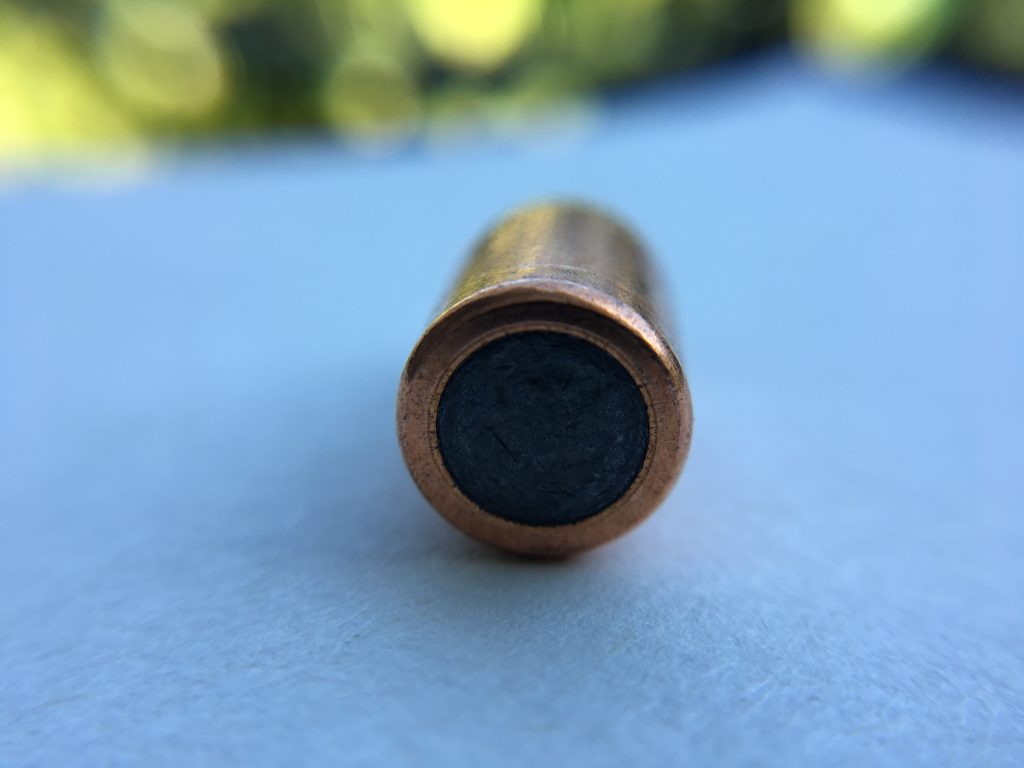
Base of a Sierra .30 carbine FMJ
Obviously there are performance differences between the three shapes. Another major thing to consider is that FMJs have the jacket pulled front to back (exposing the lead core at the base) while SPs and HPs have the jacket drawn back to front. Ladies should always go front to back, for guys it doesn’t matter as much. The copper jackets allow these bullets to be driven at very high velocities and control the expansion of the bullet when it strikes a target. The copper jacket also makes lead build up the bore a non-issue.
Plated Bullets:
Think of plated bullets as a nice middle ground between cast lead and jacketed. They are cleaner than lead but still cant be driven upper end jacketed velocities.
Copper plated bullets start out similar to the core forming process of jacketed bullets. First, lead billets are hydraulically extruded into wire. Then the wire is cut to length and swagged into the shape of the bullet. These lead bullets will come out undersized on purpose. The next process is copper plating, you probably did a junior version of this with a penny and nail in chemistry in high school. It’s the same basic principle that is used in most metallic plating processes.
The bare lead is dropped into an electrolytic bath where pure copper rods are given a positive charge (anode), and the lead is given a negative charge (cathode). The liquid is the bath will form an ionic solution. Direct electric current is applied which causes the copper to ionize then oxidize and dissolve into the water. The lead begins attracting and building a thin layer of copper. The lead is removed when the copper plating reaches the desired thickness, and viola! You have a lead bullet that is copper plated.
After the plated bullets are removed from the bath they are re-struct to ensure a uniform size and shape. Different manufactures plate to different thicknesses, but each manufacturer will let you know what the bullets are rated for. Typically the thicker the plating the faster you can push them. Regardless of thickness I’ve never seen anything rated over 1900fps. Most are rated to 1250, and some to 1500fps.
Bullet Profiles:
Now that we understand the different bullet manufacturing methods, lets run through the different profiles. These profiles are independent of manufacturing method and just describe the shape. Luckily we have acronyms to help us remember. You should use them as much as possible because they make you seem cool. Cool people have more sex and live longer. These are the ones used by Xtreme:
Round Nose (RN):
This is the most common bullet style. Old timers will refer to jacketed FMJ round nose as “ball” or “hardball”. They feed in just about anything and are a great all around target or plinking choice. I use his for my plinking rounds because they are the most common and the most economical.
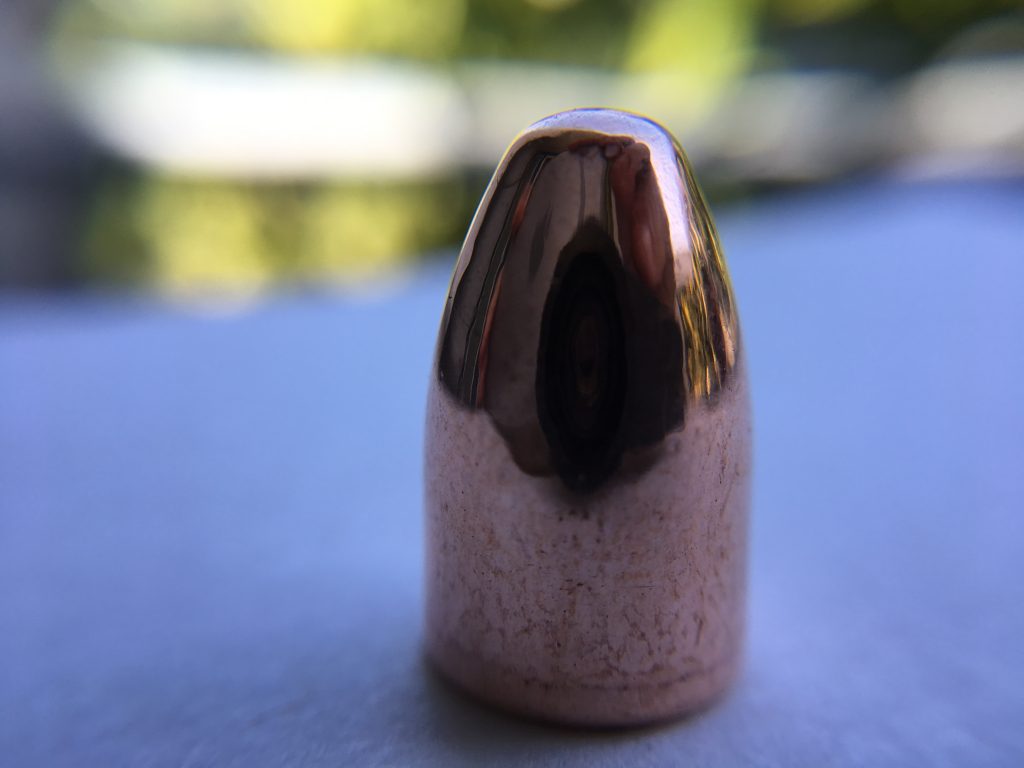
Xtreme 124gr 9mm Round Nose
Round Nose Flat Point (RNFP):
This is the same as the round nose, but the tip is blunted a little to keep the overall length (OAL) down. The 135 gr from extreme makes a great compromise if you’re having a hard time choosing between 124 and 147. I had a fun load for this in 9mm with the now discontinued IMR PB powder.
Flat Point (FP):
In some of the heavier bullet offerings manufacturers will make a flat nose bullet to keep the OAL down. You see these all the time in 40 S&W. The blunted area at the tip of the bullet is called a meplat (French for flat).
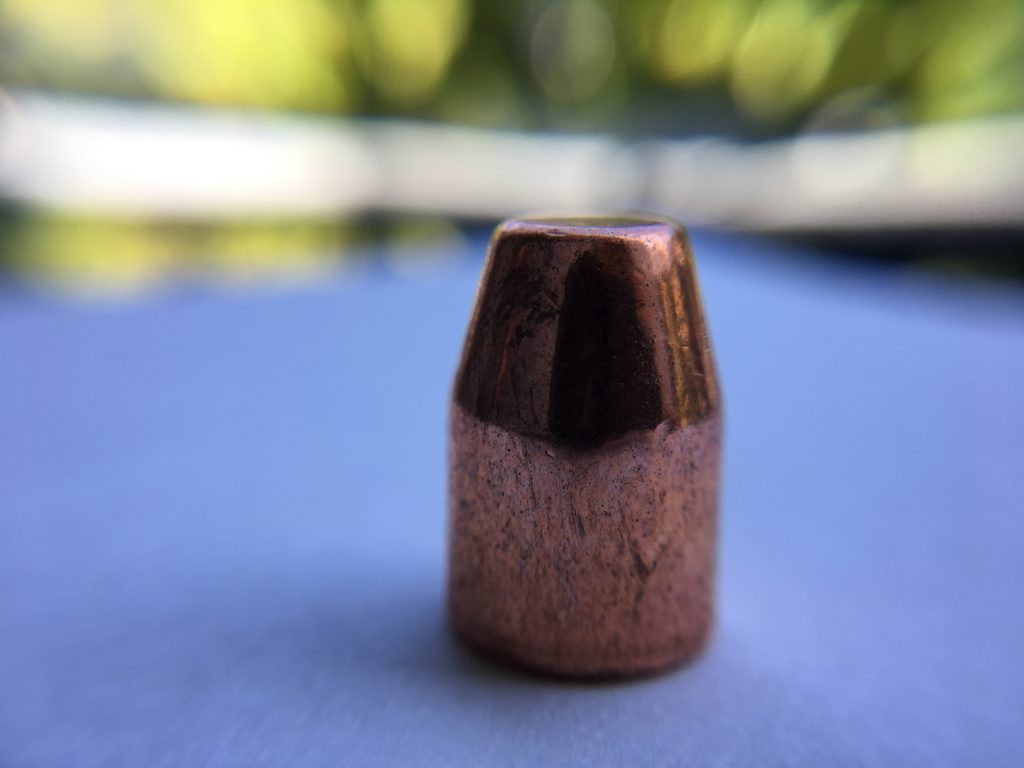
Xtreme 124gr 9mm Flat Point
Wad Cutter (WC):
Wad cutters do exactly that, they cut a wad out of your targets. These are almost perfect cylinders that punch a perfect wad of paper out of your target, giving you a hole in your target the exact diameter of your bullet. They are very accurate at close ranges and are used for target shooting and some specific competitions. You pretty much only see them in revolvers because they wont feed in semi autos.
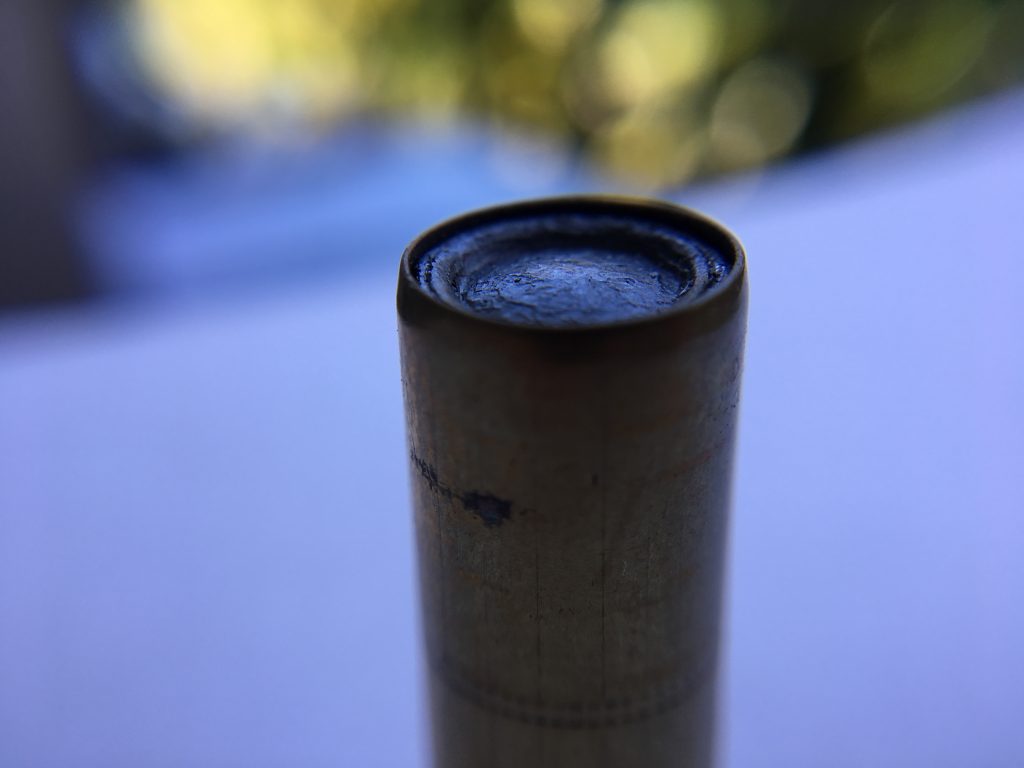
Some vintage wad cutters, these shoot really really well out my 6″ model 19
Semi Wad Cutter (SWC):
Like a wad cuter and a flat point had a baby. All the wad cutting goodness, but they also feed in semi autos, sometimes…
Hollow Point (HP):
Hollow points are typically designed for expansion when they impact a target. If they are not designed as defensive or hunting rounds then they are most likely a jacketed bullet that has the jacket drawn forward for accuracy (think Sierra Match King (SMK)). The hollow points from Xtreme are not designed for defensive or hunting purposes, nor are they jacketed, so I have no fucking idea what the advantage is.
Heavy Plate Concave Base (HPCB):
In an effort to reduce the likelihood or amount of gas that blows by the bullet in the bore, some bullets are designed with a concave base. This results in the gases pushing the edges of the base of the bullet into further into the lands and grooves (and increase the bearing surface). It’s also plated thicker for higher velocities. This is a more expensive option, but if you’re running 9mm major this is the bullet for you.
Reloading Bullets
Plated bullets are easy to reload, but there are a few things to consider. First and foremost make sure you pick a plated bullet that will handle your intended velocity. Next you need to realize there is not nearly as much published data on plated bullets as there is for cast lead or jacketed. Some manuals will list Rainier bullets or Speer gold dots. Gold dots are heavily plated and designed for defensive purposes. If you can’t find any data for plated some people say to split the difference between jacketed and lead in terms of max load/velocity. I personally have always been able to find some load data. Especially with the powder manufacturers adding online configurators.
Can you Crimp Plated Bullets?
Crimping can present an issue for plated bullets, although I think most people freak out over nothing. If you roll crimp a plated bullet too much you will can cut through the plating. This can lead to the bullets shedding the copper plating from the crimp to the base of the bullet when it is traveling down the bore. This is not good because you will get extreme lead fouling/galling and shitty accuracy.
Everyone you talk to jerks themselves off about how you have to be careful when you crimp with plated bullets. In reality 99% of those people are taper crimping because they are shooting a semi auto. I don’t know if you could even taper crimp enough to cut through the plating. Since most semi-autos head space off the case mouth I think you would have bigger problems if you went all Bruce Banner and taper crimped through the plating. In my experience I’ve had exactly ZERO issues related to over-crimping, and a SHIT TON related to under crimping.
Hence this quick pic of what happens when you don’t crimp enough:

Always do the push test to verify your crimp
Yeah you’re seeing that right. I attempted to jack a round out of the chamber and ended up separating the bullet from the case. While this is irritating it’s not particularly dangerous, unless the bullet goes the other way and get pushed into the case when it hits the feed ramp. That’s called bullet set back and it’s a great way to blow your gun up.
Will Plated Bullets work with my rifling?
Short answer: Maybe. This is another one of those things that gets repeated on forums all the damn time. The two types of rifling you want to be aware of are polygonal and micro groove. I’m sure everyone has heard of polygonal because everyone and their mom finger bangs themselves over Glocks. The factory barrels from Glock have earned a reputation for not liking lead, plated, and coated bullets. Some of this is based in truth, most is people just repeating something they heard. In reality the issue is a combination of polygonal rifling, bullet diameter not matching the bore, and the internal barrel coating. When anyone of these (or all of them) get too out of whack it can cause rapid leading of the bore. Which can result in the notorious Glock KB (Kaboom!).
That’s one of the reasons people by aftermarket barrels like Lone Wolf. The other reason is because people just like spending money. I don’t own a Glock because if I wanted to shoot a plastic gun with a shitty trigger I would go to my nearest arcade, then punch myself in the dick.
The picture below is standard rifling in my M1 Carbine. You’ll see why this is relevant when you see Mirco Grove in a minute.
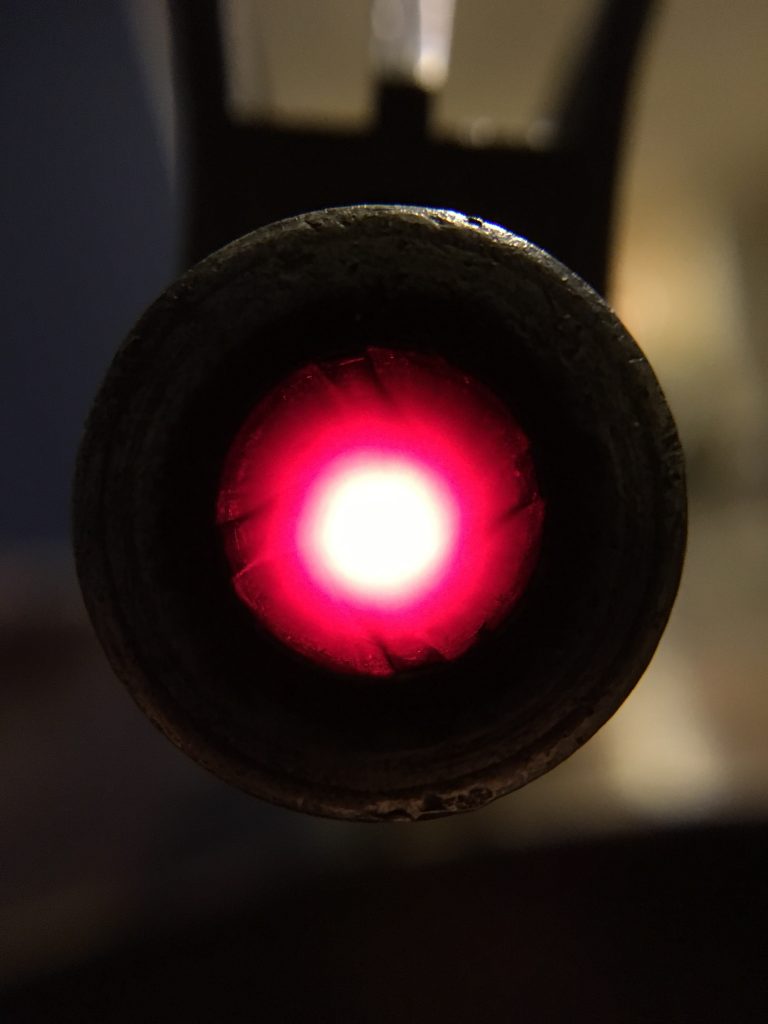
M1 Carbine rifling
While I can’t personally comment on the polygonal rifling, I can talk about microgroove. Back in the 50s Marlin started using a new rifling scheme called microgroove. Basically it had 2-3 times the number of groves that standard rifling schemes did, and the bore was slightly larger than standard.
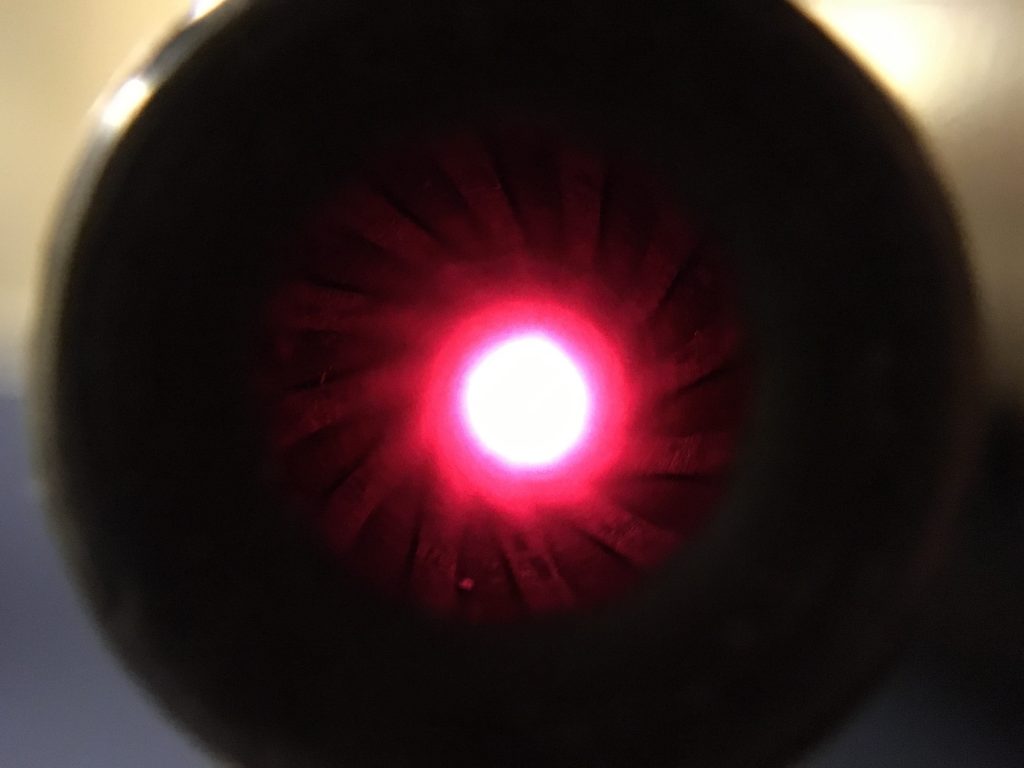
1980 Marlin 1894c Micro groove rifling
They said that this would decrease fouling, lower chamber pressure, increase accuracy…blah, blah, blah. Well it turns out it works great if you match your bullet size to the bore. Anytime you don’t match bullet to bore, especially with cast lead, you might as well file your sights off, cause they won’t help you. I shot some 158gr RNFP plated Xtreme Bullets out of my micro groved marlin and got 36” patterns at 35 yards. Yeah I said patterns, if your “group” is that large at that close a distance is ceases to be a group and becomes a pattern.
Accuracy:
In my experience Xtreme Bullets will shoot as tight as I can hold in my CZ 75 Shadow. What do I mean by that? In order to see bullets landing somewhere other than where I’m aiming I would need to be shooting off bags, or have the pistol in a ransom rest. I can consistently shoot ragged one-hole groups offhand at 7 yards. If you miss a target in USPSA, IDPA, or ICORE it’s because you missed, not because the bullets are inconstant. There are a bunch of shooters out there that blame their gear for poor performance. We’re old enough to know that its not the gear. Are there more accurate bullets out there? Probably, but will using them help your performance is most action pistol sports? No, and you’ll end up spending more money and shoot less.
Cost to Reload Bulk 9mm Ammo?
For the longest time extreme only sold 500 round boxes. I know this because I bought a shit load of them, and would have loved a bulk option. Now they offer big ass buckets.
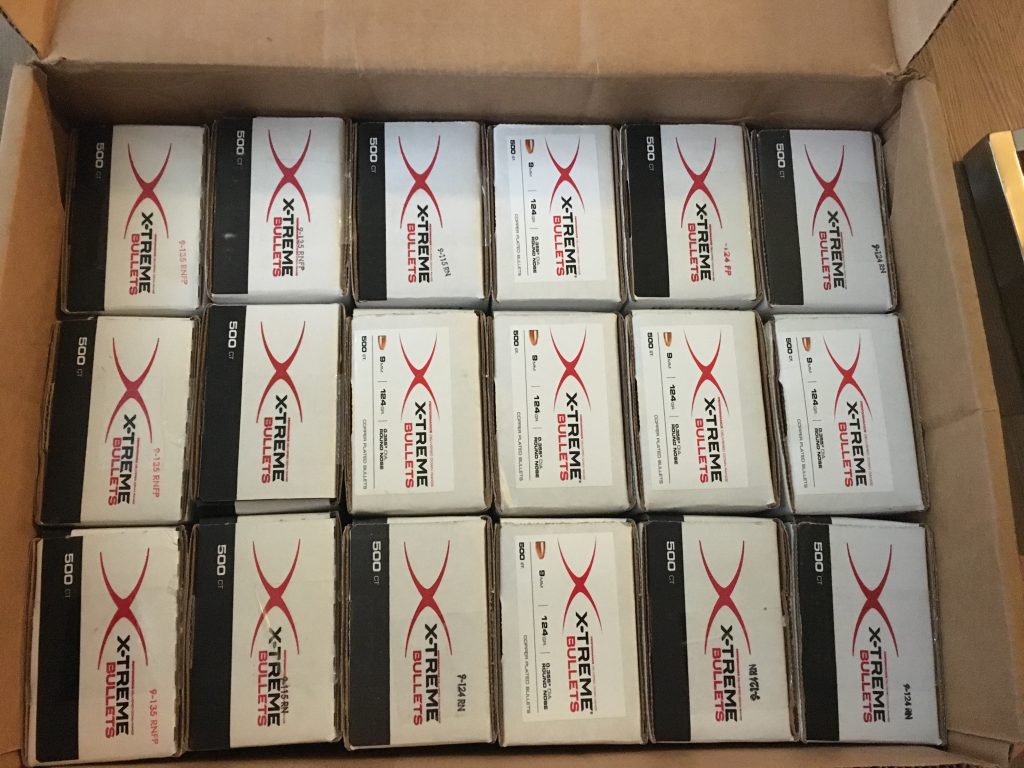
500 round boxes of Xtreme Bullets
They have always been roughly $.08 cents a piece for 115gr 9mm, plus shipping. That’s not a bad price, but it’s not a screaming deal either. Xtreme Bullets compete with Berry’s, Rainier, RMR, plus all the coated brands. Also, when you get up around the $.10 per bullet price you are in jacketed territory now. And there is honestly no reason to shoot plated over jacketed if they are the same price.
Bulk Reloading Bullets
The trick is not to pay full retail by taking advantage of America’s endless supply of holidays. They generally run free shipping, or free shipping plus 10% off for Memorial day, 4th of July, labor day, black Friday, Kwanzaa…etc. When they run a deal grab a cupon code and scoop up enough to last you till the next holiday.
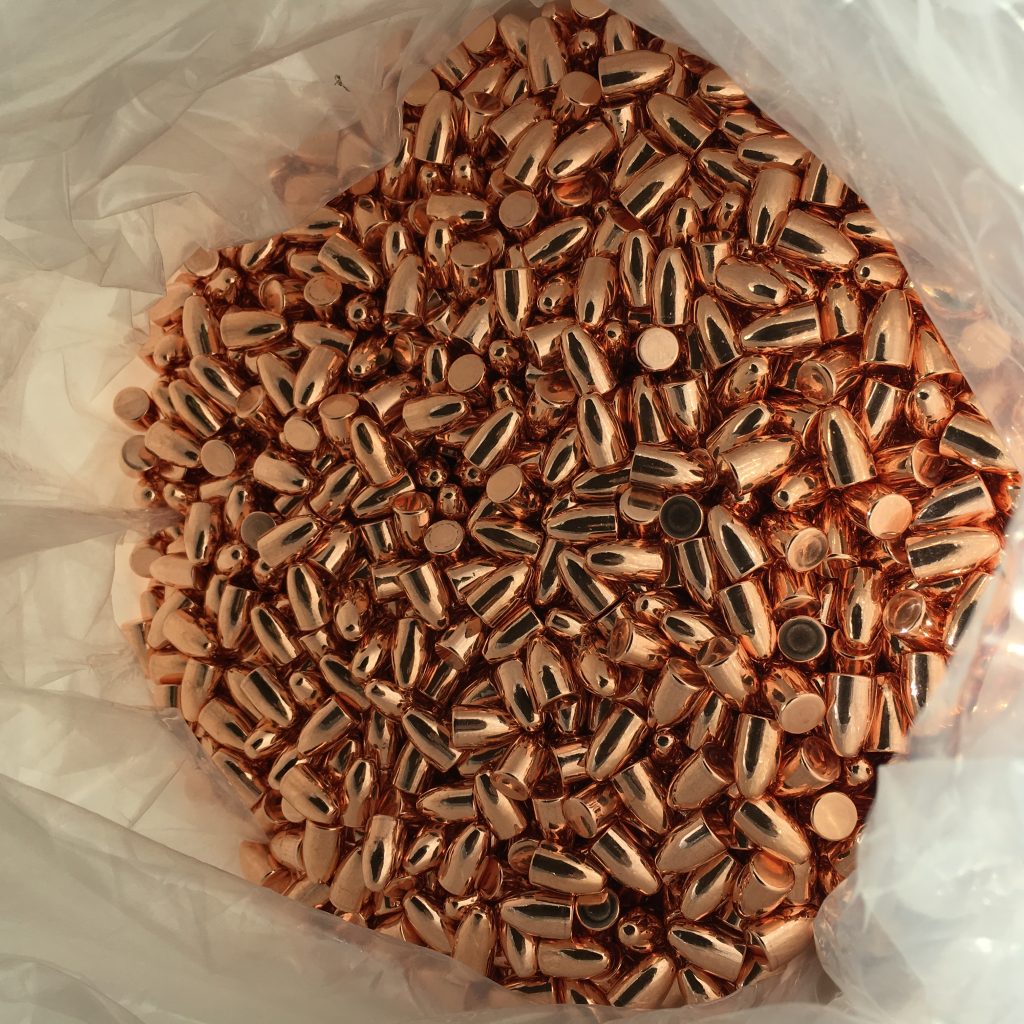
3750 round bucket of Xtremes
Bulk Reloading Supplies
In order to get the component costs this low you need to be buying in bulk. 8lbs kegs of powder ordered at the same time as your primers make sure you only have one Hazmat charge. Plus if you group buy with your friends you can split Hazmat and shipping more than one way.
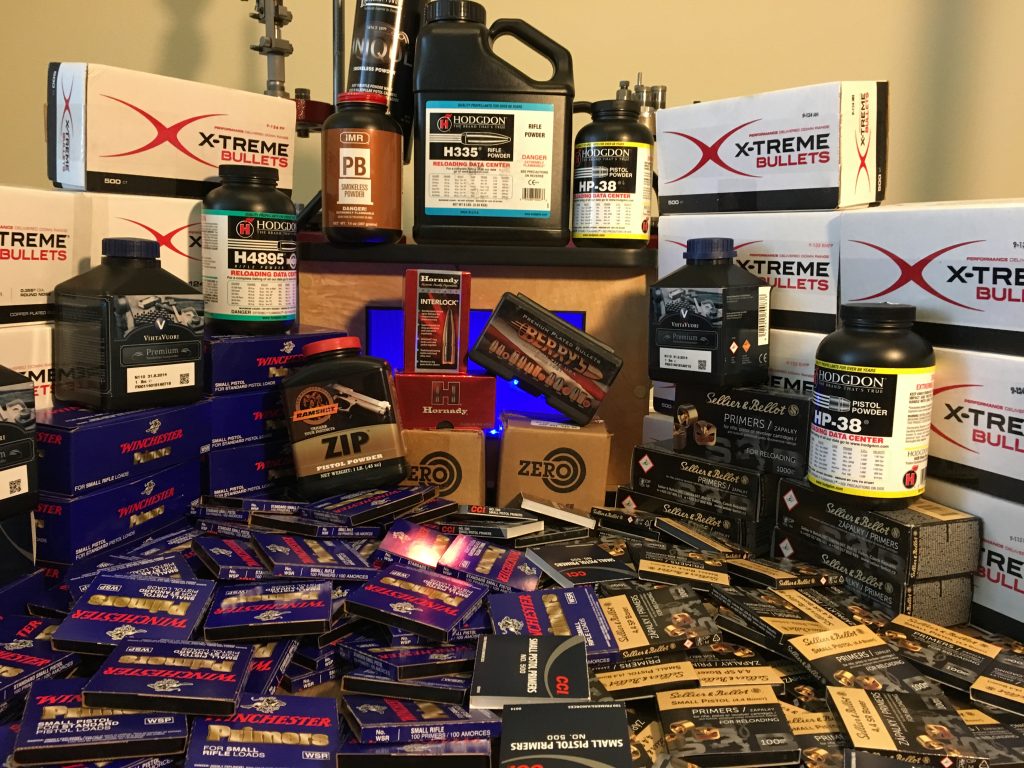
Every penny counts
Last black Friday I picked up a bucket of 3750 124gr 9mm for $285 , 20% off (-$57.00), plus free shipping. This cost me $.0608 per bullet delivered, plus I get a sweet ass bucket! When you add in my powder cost of roughly $.02 (4.2gr HP-38) and my primer cost of roughly $.025 (Sellier and Bellot small pistol)we land at a loaded round price of $.105.
Berrys Bullets
This is one of Xtreme’s biggest competitors, and the oldest bullet manufacturer I’ll cover today. They offer similar profiles and performance, but seem to be slightly more expensive. The one area that Berry’s is ahead of Xtreme Bullets is their plated rifle bullets. I shoot a shit ton of .30 carbine because it’s my favorite rifle. If you don’t have one then sell your 2nd AR and go buy one, you classless twat. The standard .30 carbine load is a 110gr FMJ at about 2000fps. FMJs from Hornady or Sierra are about $.15 a round, vs about $.07-.08 for Berry’s. Xtreme is about the same price as Berry’s for these, but Xtreme’s cutoff is 1500fps vs Berry’s 1750fps.
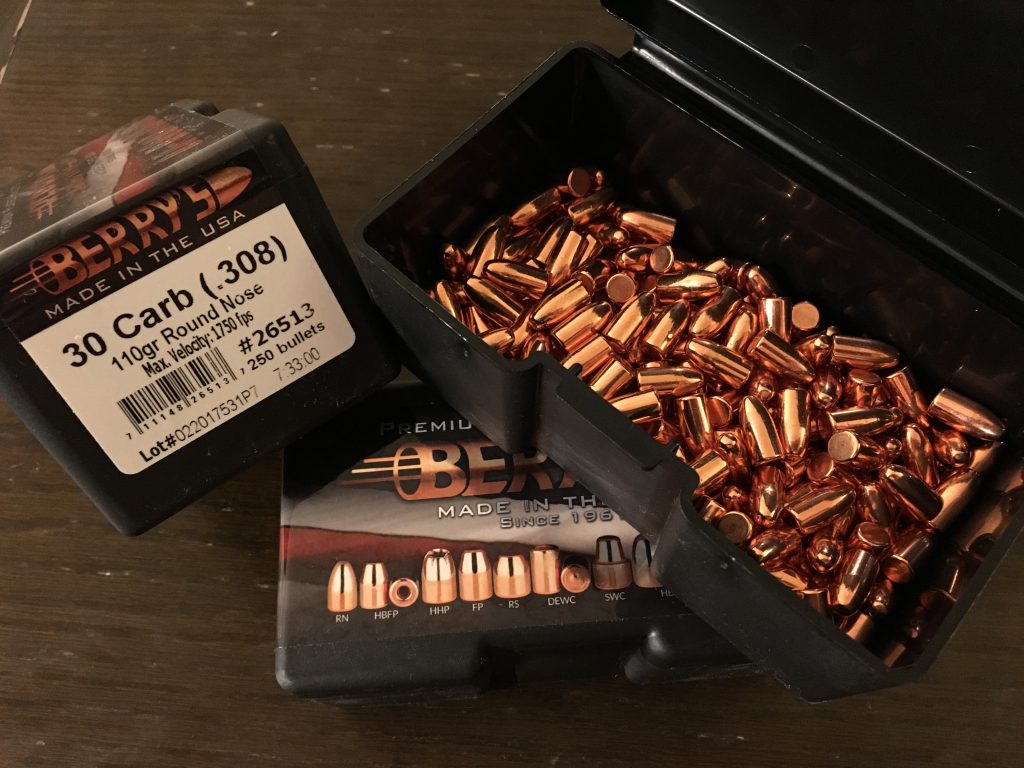
Berry’s .30 carbine
This doesn’t seem like a huge difference until you take into account that your carbine wont cycle with reloads less than about 1700fps. So unless you want a single shot carbine, you better run Berry’s or Rainier plated rounds. Also, you should read more about M1 Carbines here, written by some awesome person.
Berry’s also came out with a cheaper version of a Speer GoldDot, which is a heavy plated bullet that has a hollow point pressed into it after plating. The Gold Dot has been my, and many agencies, got-to hollow point for years.
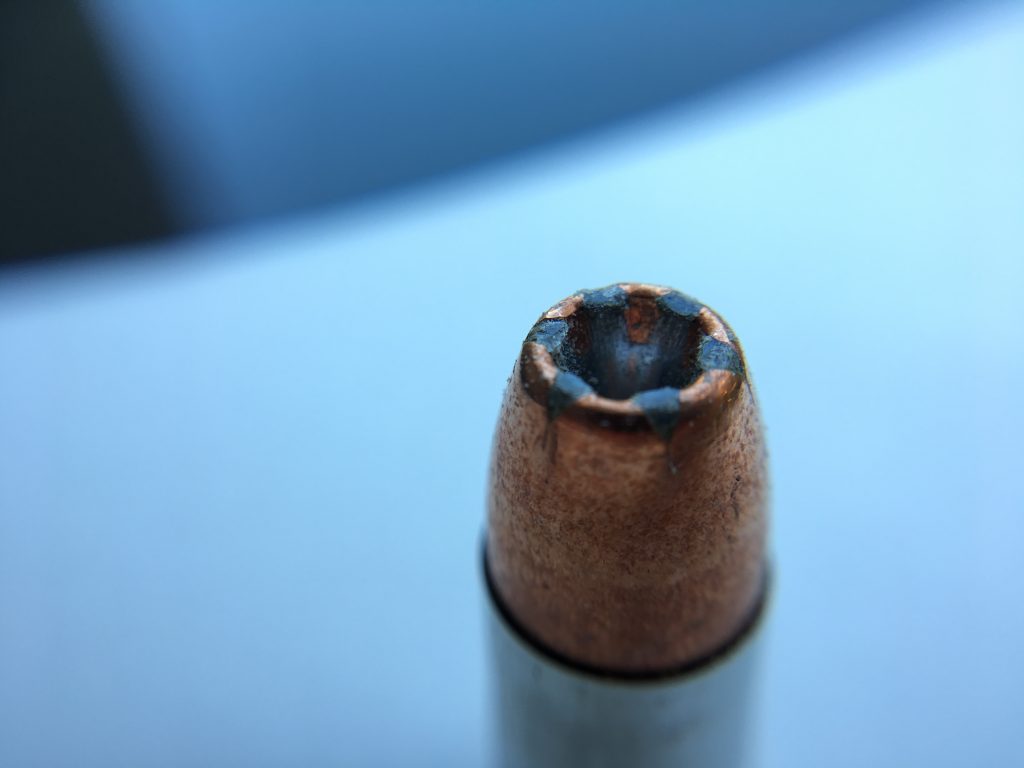
124gr 9mm Speer Gold Dot
The Berry’s version, called the “Hybrid Hollow Point”, is a great way to cost effectively load semi-defensive rounds. I say semi because the are relatively new, and first reports show that they are a little more velocity sensitive than the original Gold Dots. They seem to shed petal if pushed too fast, rather than continuing to mushroom.
Rainier Bullets
Rainier is one of the big three plated bullet manufacturer (Xtreme, Berrys, Rainier). I’ve never shot Rainier bullets because they don’t sell direct. In the reloading game pennies count, and the distributor markup puts them near the same price as jacketed. They’ve been around longer than Xtreme, but not as long as Berry’s. I see them in reloading manuals pretty often, and I’ve never heard a bad thing about them. I wish I had more to tell you. Bottom line is if you can find them for a good price you wont be disappointed.
So to tie this whole post up in a neat little list:
- If you’re plinking don’t get conned into buying expensive jacketed target bullets. They won’t make you a better shooter. Shooting makes you a better shooter.
- Plated bullets are lead bullets plated in a thin layer of copper.
- Determine the velocity you want so that you can pick the correct bullet.
- Pull a bullet to check your crimp.
- Test in small quantities to make sure the bullet likes your barrel or vice versa.
- Buy in bulk during holiday sales once you get your load figured out.
- Beer

